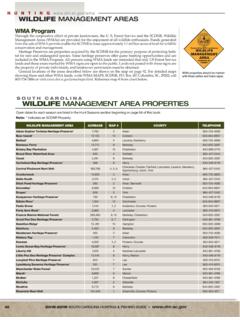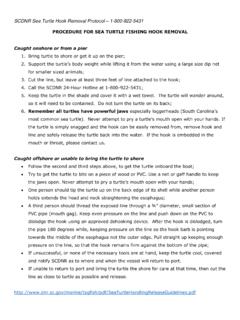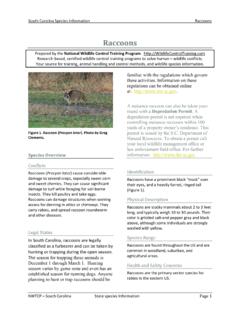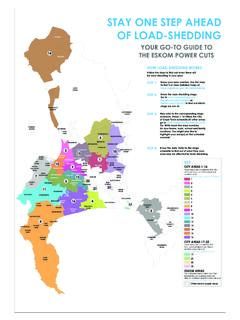Transcription of oh roina TROU ISHING
1 South CarolinaTROUT Fishing in South Carolina 3 History Management Stocking Walhalla Fish HatcheryThe Trout Streams 8 Chattooga River East Fork of the Chattooga Chauga River & Its Tributaries Whitewater River Eastatoee River & Its Tributaries Saluda River & Its Tributaries Other StreamsLake Jocassee 16 The Tailwaters 17 Lake Hartwell Lake MurrayKnow Your Quarry 19 Brook Rainbow BrownTrout Fishing Methods 21 Headwaters Streams Lakes TailwatersTrout Flies for South Carolina 25 Spring Fishing Summer Fishing Fall Fishing Winter FishingTrout Fishing Lures 28 How to Get There Access Areas 30 Map 1: Lower Chattooga River _____33 Map 2: Lower Chattooga & Chauga River _____35 Map 3: Middle & Lower Chattooga River _____41 Map 4: Upper Chauga & Middle Chattooga River _45 Map 5: Upper Chattooga Ridge _____47 Map 6: Jocassee Gorges _____512 Map 7: Eastatoe Creek Mainstem & Tributaries ___53 Map 8: Table Rock _____57 Map 9: Mountain Bridge _____59 Map 10: North Saluda River _____61 Map 11: Chestnut Ridge_____63 Map 12: Lake Hartwell Tailwaters _____67 Map 13.
2 Lake Murray Tailwaters _____69 Popular South Carolina Managed Trout Streams 70 Your Responsibility As a Sportsman 71 Proper Catch and Release Techniques Wader Washing, Preventing Exotics & DiseaseContacts for More Information 73 State Fishing Rules and Regulations State Fishing License Lodging and Camping Facilities Trout Fishing Organizations3 TROUT FISHING IN SOUTH CAROLINA Trout fishing in South Carolina? Most folks don t think of South Carolina as a trout fishing state. Yet, surveys of anglers indicate as many as 50,000 trout anglers take to the waters each year. These anglers contribute approximately $18 million to the state s economy as a result of trout angling. Blue Ridge headwater trout streams stretch across three Upstate counties.
3 One large coldwater reservoir and numerous mountain lakes and ponds also entice trout anglers. Two tailrace fisheries, one in the Piedmont and another in the Midlands, accentuate the diverse trout resource in South Carolina. Another bonus, the majority of South Carolina s trout resources occur on publicly owned and accessible lands. These resources offer trout anglers varied opportunities, whether they are after the creel limit for the evening s meal, outsmarting that one special trophy, or testing the latest dry fly on a remote Carolina harbors three spe-cies of coldwater trout: brook, rainbow and brown. Alternately described as the aristocrats of fishes and the high priests of mountain streams, these fish are revered by every sporting trout fisherman for their beauty and Carolina s trout fishing is primarily found in the northwest corner of the state where the Appalachian Mountains fall off the Blue Ridge Escarpment into the foothills of Oconee, Pickens and Greenville counties.
4 Here, the tributaries draining the higher elevations comprise the mountain streams, which the South Carolina Department of Natural Resources (SCDNR) manage for biologists have developed year-round trout fisheries in or below three man-made reservoirs. In Oconee and Pickens counties the 7,500-acre Lake Jocassee is known as a trophy fisherman s dream, where two-to six-pound trout are taken frequently. Occasional catches of 10-pound trout reward the persistent angler. Spring trout fishing is also available in the tailraces below Lake Hartwell in Anderson County and Lake Murray in Lexington County. While fishing the tailraces can be a fine experience, trout fishing in Michael Foster4 South Carolina s mountains is truly a thrilling experience for the angler seeking a unique and different challenge.
5 However, chances are you won t be disappointed, no matter where you trout fisheries are also available in smaller lakes in the mountains of South Carolina. During the colder months (November through April), several state and county park lakes, as well as US Forest Service (USFS) lakes, are stocked with trout. Lakes routinely stocked include Oconee State Park Lake, Burson s Lake (Oconee County), Pinnacle Lake (Table Rock State Park), and Pleasant Ridge County Park Lake (Greenville County).HISTORYP erhaps more than other wildlife, the trout s tenuous survival in South Carolina can be traced back to the effects of man s activities on the environment. Since trout only live in pure, cold water, they are highly sensitive to excessive silt loads, increased water temperatures, and lowered oxygen levels.
6 When improperly conducted, practices such as logging, agriculture, residential development, and dam and highway construction can effectively destroy many trout-producing habitats. At the same time, a growing number of anglers adds to the pressure on the remaining eastern brook trout is the only species of the salmon and trout family native to the southern Appalachians and South Carolina. Though called a trout since its discovery by early European settlers, it is actually a believe the brook trout first arrived in the southern Appalachians during the Pleistocene Epoch, which began about million years ago and ended about 11,000 years ago. Prior to then, it occurred in the region from New Jersey north to the Hudson Bay. Aided by the cold climate created by advancing and retreating glaciers, the brook trout found a new home in the southern Appalachians.
7 The brook trout s security in the unspoiled mountain wilderness gradually changed with the influx of European settlers in the 1800s. Records from the 1870s note the presence of healthy populations of eastern brook trout in the upper Chattooga River. Land use practices of the late 19th and early 20th centuries forced the brook trout to retreat to the state s most remote , the trout s decline did not pass unnoticed. The rainbow trout from the Western US and the brown trout from Europe were imported. These introductions had both positive and negative implications. On one hand, brown and rainbow trout were arguably able to occupy warmer water temperatures in the degraded habitat, and extend farther downstream of 5historic brook trout habitat.
8 Therefore, these introductions likely increased available natural trout waters, alerted conservationists to protect the trout s habitat, and helped create the vast southern Appalachian trout resource anglers enjoy today. On the other hand, the introduction of non-native trout resulted in the displacement of brook trout from their native range, in many cases. MANAGEMENTS ince South Carolina has only a comparatively small amount of water suitable for trout management, there is very little room to make mistakes. With the help of a supportive public, over the years, the trout resource and trout fishing have been preserved. Trout management is defined as any activity having a positive impact on the well being of the trout resource, such as habitat protection and management, population management, regulations, stocking and research.
9 Habitat preservation is the foundation of successful trout management. Every mile of natural stream lost to impoundments, every degree that habitat alteration increases water temperature, and every activity that increases the silt load in streams, means less habitat and less trout. Through public education and outreach, habitat protection and restoration, and population monitoring and management, trout managers are trying to reverse errors of the past. Private landowners of trout streams are encouraged to contact local SCDNR biologists for information and to learn more about SCDNR programs for protecting and improving trout Jones6 STOCKINGIn the early 1930s, the SCDNR and US Fish and Wildlife Service began trout culture and stocking programs.
10 Managers concentrated on stocking fingerling size trout, in the early years, in an attempt to re-establish sustaining trout populations or to establish put-grow fisheries where natural trout reproduction was limited. As the program evolved in the 1950s and 1960s, the Wildlife and Marine Resources Department (today s SCDNR) began an extensive trout stocking program to provide more trout fishing opportunities for the angler. This program included expanding trout management in seasonal, hatchery-supported mountain trout waters by stocking more catchable size trout. The SCDNR now annually stocks approximately 500,000 fingerlings and catchable size brook, brown and rainbow trout. Approximately fourteen mountain streams are stocked on a regular basis with catchable size (9-12 inch) trout from March through June and again during October and November.

















